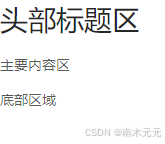前言
? 大家好,我是南木元元,热爱技术和分享,欢迎大家交流,一起学习进步!
? 个人主页:南木元元
目录
什么是slot插槽
默认插槽
编译作用域
后备内容
具名插槽
作用域插槽
应用场景
动态插槽名
废弃的插槽语法
默认插槽
具名插槽
作用域插槽
总结
结语
什么是slot插槽
Vue官方文档:Vue实现了一套内容分发的 API,将<slot>元素作为承载分发内容的出口。
通俗来讲,就是“占坑”,使用<slot></slot>在子组件模板中占好位置,父组件就可以向其中传递一些内容。
Vue 的插槽可以分为三类:
默认插槽具名插槽 作用域插槽默认插槽
默认插槽又名匿名插槽,是最简单的插槽形式,当slot没有指定name属性值的时候为一个匿名插槽(一个组件内只有一个匿名插槽)。
示例:
// 子组件Child<template> <div class="child"> <!-- 默认插槽:这个内容会被父组件传递的内容替换 --> <slot></slot> </div></template>// 父组件Parent(引用子组件Child)<template> <Child>南木元元</Child></template>渲染结果:
<template> <div class="child"> 南木元元 </div></template>![]()
子组件中使用默认插槽slot,实现了父组件向子组件的指定位置插入一段内容,即内容的分发。
编译作用域
我们可以通过slot向子组件传递父组件内任意的data值,比如:
// 父组件Parent(引用子组件Child)<template> <Child>{{ msg }}</Child></template><script>import Child from "./child.vue";export default { components: { Child, }, data() { return { msg: "父组件", }; },};</script>但我们能否直接使用子组件内的数据呢?答案是不行的。
// 子组件Child<template> <div class="child"> <!-- 默认插槽:这个内容会被父组件传递的内容替换 --> <slot></slot> </div></template><script>export default { data() { return { child: "子组件", }; },};</script>// 父组件Parent(引用子组件Child)<template> <!-- 不能访问子组件的作用域 --> <Child>{{ child }}</Child></template>因为有一条规则:
父级模板里的所有内容都是在父级作用域中编译的;子模板里的所有内容都是在子作用域中编译的。
后备内容
后备内容,就是slot的默认值,有时我们没有在父组件中提供内容,那么slot就会显示默认值,如:
// 子组件Child<template> <div class="child"> <!-- 父组件没有提供内容时显示后备内容 --> <slot>这是插槽的后备内容</slot> </div></template>// 父组件Parent(引用子组件Child)<template> <!-- 父组件没有向插槽提供内容 --> <Child></Child></template>渲染结果:
![]()
具名插槽
具名插槽是指带有name属性的slot,一个组件可以出现多个具名插槽。
有时需要多个插槽,我们就可以使用具名插槽,根据名称将不同内容精确分发到不同位置。
示例:
子组件
// 子组件Child<template> <div class="child"> <!-- 具名插槽:带name的slot --> <header> <slot name="header"></slot> </header> <main> <slot></slot> </main> <footer> <slot name="footer"></slot> </footer> </div></template>父组件中,需要在一个 <template> 元素上使用 v-slot:name 或 #name(v-slot:name的缩写,2.6.0 新增)的形式向具名插槽提供内容。
// 父组件Parent(引用子组件Child)<template> <Child> <!-- 具名插槽header --> <template v-slot:header> <h1>头部标题区</h1> </template> <!-- 这是默认插槽 --> <p>主要内容区</p> <!-- 具名插槽footer,使用缩写形式 --> <template #footer> <p>底部区域</p> </template> </Child></template>渲染结果:

注意:上面示例中,<template>元素中的所有内容都将会被传入相应的插槽,而没有被包裹在带有v-slot的<template>中的内容都会被视为默认插槽的内容。
<p>主要内容区</p>// 上面等价于下面这种写法<template v-slot:default> <p>主要内容区</p></template>作用域插槽
前面我们说过,父组件中不能直接使用子组件内的数据。如果父组件要使用子组件中的数据,我们可以使用作用域插槽。该插槽可以将子组件数据传给父组件,让父组件根据子组件的传递过来的数据决定如何渲染内容。
// 子组件Child<template> <div class="child"> <header> <!-- 向具名插槽中传入子组件的数据 --> <slot name="header" :message1="child1"></slot> </header> <main> <!-- 传入子组件的数据,这里没有命名slot --> <slot :message2="child2"></slot> </main> </div></template><script>export default { data() { return { child1: "消息1", child2: "消息2", }; },};</script>// 父组件Parent(引用子组件Child)<template> <Child> <!-- 通过v-slot的语法,将子组件的message1值赋值给headerProps --> <template v-slot:header="headerProps"> {{ headerProps }} <br /> {{ headerProps.message1 }} </template> <!-- 由于子组件没有给slot命名,默认值就为default --> <template v-slot:default="defaultProps"> {{ defaultProps.message2 }} </template> </Child></template>渲染结果:

应用场景
作用域插槽在组件封装时非常有用,它能够在保持组件逻辑封装的同时,还能允许父组件根据子组件的数据进行自定义渲染,从而在增强组件复用性和灵活性的同时保持良好的封装性。
我们来看个案例:下面封装了一个列表组件,主要负责渲染展示一个列表,数据由父组件传递。
// 子组件Child<template> <div class="child"> <h3>{{ title }}</h3> <p v-for="item in list" :key="item.id">{{ item.id }}.{{ item.text }}</p> </div></template><script>export default { name: "Child", props: ["title", "list"],};</script>// 父组件Parent(引用子组件Child)<template> <Child :list="list" :title="title"> </Child></template><script>import Child from "./child.vue";export default { components: { Child, }, data() { return { title: "名人名言", list: [ { id: 1, text: "成功就是从失败到失败,也依然不改热情。", }, { id: 2, text: "成为你自己想要看到的改变。", }, { id: 3, text: "努力并不会背叛你,哪怕一时看不到回报。", }, ], }; },};</script>效果:

但存在一些问题,当有些页面需要复用该组件展示列表时,比如,需要在title处增加一个图标,或者在展示内容时不显示编号1、2、3,就不够灵活。
这时,我们就可以通过作用域插槽,将列表元素内容和样式的控制权交给使用它的父组件来控制。
复用该组件时在title处添加图标:
// 子组件Child<template> <div class="child"> <h3> <!-- 通过插槽将title传给父组件 --> <slot name="title" v-bind:titleValue="title"> {{ title }} </slot> </h3> <p v-for="item in list" :key="item.id"> <!-- 通过插槽将列表元素传给父组件 --> <slot name="text" v-bind:itemValue="item" >{{ item.id }}.{{ item.text }} </slot> </p> </div></template><script>export default { name: "Child", props: ["title", "list"],};</script><style scoped></style>// 父组件Parent控制标题的显示(引用子组件Child)<template> <Child :list="list" :title="title"> <template v-slot:title="slotTitle"> <!-- title处添加图标 --> <a-icon type="smile" />{{ slotTitle.titleValue }} </template> </Child></template>效果:

展示内容时不显示编号1、2、3:
// 父组件Parent控制列表元素的显示(引用子组件Child)<template> <Child :list="list" :title="title"> <template v-slot:text="slotItem"> {{ slotItem.itemValue.text }} </template> </Child></template>效果:

通过作用域插槽,父组件完全控制了如何展示列表项,而不需要修改子组件的内部逻辑。
动态插槽名
2.6.0 新增:动态插槽名
动态指令参数也可以用在 v-slot 上,来定义动态的插槽名:
<Child> <template v-slot:[dynamicSlotName]> ... </template></Child>这里方括号中的dynamicSlotName会作为一个 JavaScript 表达式被动态执行,计算得到的值会被用作最终的参数。
废弃的插槽语法
以上的插槽语法是Vue 2.6.0后的语法,在这之前,插槽语法为slot(默认插槽或具名插槽)和slot-scope(作用域插槽)。
vue官网:v-slot指令自 Vue 2.6.0 起被引入,提供更好的支持 slot 和 slot-scope attribute 的 API 替代方案。在接下来所有的 2.x 版本中 slot 和 slot-scope attribute 仍会被支持,但已经被官方废弃且不会出现在 Vue 3 中。
默认插槽
父组件省略不写或者在template上使用slot属性:slot="default",将内容从父级传给默认插槽。
// 子组件Child<template> <div class="child"> <!-- 默认插槽:这个内容会被父组件传递的内容替换 --> <slot></slot> </div></template>// 父组件Parent(引用子组件Child)<template> <Child> <template slot="default"> 南木元元 </template> </Child></template>具名插槽
父组件在template上使用slot属性:slot="name",将内容从父级传给具名插槽。
// 子组件Child<template> <div class="child"> <!-- 具名插槽:带name的slot --> <header> <slot name="header"></slot> </header> <main> <slot></slot> </main> <footer> <slot name="footer"></slot> </footer> </div></template>// 父组件Parent(引用子组件Child)<template> <Child> <!-- 具名插槽header --> <template slot="header"> <h1>头部标题区</h1> </template> <!-- 这是默认插槽 --> <p>主要内容区</p> <!-- 具名插槽footer --> <template slot="footer"> <p>底部区域</p> </template> </Child></template>作用域插槽
父组件在template上使用slot-scope属性,可以接收传递给插槽的 prop。
// 子组件Child<template> <div class="child"> <header> <!-- 向具名插槽中传入子组件的数据 --> <slot name="header" :message1="child1"></slot> </header> <main> <!-- 传入子组件的数据,这里没有命名slot --> <slot :message2="child2"></slot> </main> </div></template><script>export default { data() { return { child1: "消息1", child2: "消息2", }; },};</script>// 父组件Parent(引用子组件Child)<template> <Child> <!-- 通过slot-scope的语法,将子组件的message1值赋值给headerProps --> <template slot="header" slot-scope="headerProps"> {{ headerProps.message1 }} </template> <!-- 由于子组件没有给slot命名,这里的slot="default"可以忽略为隐性写法 --> <template slot-scope="defaultProps"> {{ defaultProps.message2 }} </template> </Child></template>效果:
![]()
slot-scope 属性也可以直接用于非 <template> 元素 (包括组件)。
<template> <Child> <!-- slot-scope attribute 也可以直接用于非 <template> 元素 --> <span slot-scope="defaultProps"> {{ defaultProps.message2 }} </span> </Child></template>slot-scope的值可以接收任何有效的可以出现在函数定义的参数位置上的 JavaScript 表达式,即可以在表达式中使用es6解构,这样写法就更加简洁了。
<template> <Child> <!-- 使用es6解构 --> <span slot-scope="{ message2 }"> {{ message2 }} </span> </Child></template>总结
最后我们来做一个小小的总结:

结语
?如果此文对你有帮助的话,欢迎?关注、?点赞、⭐收藏、✍️评论,支持一下博主~